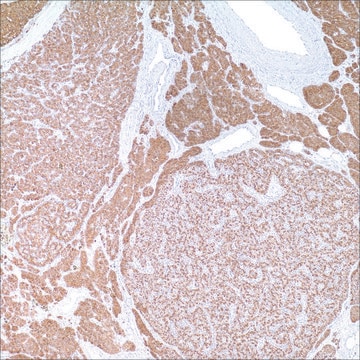308M-1
Oct-2 (MRQ-2) Mouse Monoclonal Antibody
About This Item
Produits recommandés
Source biologique
mouse
Niveau de qualité
100
500
Conjugué
unconjugated
Forme d'anticorps
diluted ascites fluid
Type de produit anticorps
primary antibodies
Clone
MRQ-2, monoclonal
Description
For In Vitro Diagnostic Use in Select Regions (See Chart)
Forme
buffered aqueous solution
Espèces réactives
human
Conditionnement
vial of 0.1 mL concentrate (308M-14)
vial of 0.5 mL concentrate (308M-15)
bottle of 1.0 mL predilute (308M-17)
vial of 1.0 mL concentrate (308M-16)
bottle of 7.0 mL predilute (308M-18)
Fabricant/nom de marque
Cell Marque™
Technique(s)
immunohistochemistry (formalin-fixed, paraffin-embedded sections): 1:25-1:100
Isotype
IgG1κ
Contrôle
tonsil
Conditions d'expédition
wet ice
Température de stockage
2-8°C
Visualisation
nuclear
Informations sur le gène
human ... POU2F2(5452)
Catégories apparentées
Description générale
Oct-2 is a transcription factor of the POU homeo-domain family that binds to the Ig gene octamer sites, regulating B-cell-specific genes. These are involved in proliferation and differentiation and despite the scarce evidence for Oct-2 expression in T cells, it has been shown that this factor participates in transcriptional regulation during T-cell activation. Oct-2 activity is dependent on phosphorylation and alternatitive splicing, although it seems that the level of its expression can be used as a marker of B-cell lineage and differentiation. The following show high levels of Oct-2 expression: germinal center B-cells, mantle B-cells, monocytoid B-cells, and plasma cells. Various lymphomas are also positive for this marker including the following: B-chronic lymphocytic leukemia, mantle cell lymphoma, follicular lymphoma, marginal zone lymphoma, plasmacytoma, Burkitt lymphoma, diffuse large cell lymphoma, diffuse large B-cell lymphoma, T-cell rich B-cell lymphoma, nodular lymphocyte predominant Hodgkin lymphoma, classic Hodgkin lymphoma.
Several studies of Oct-2 expression have shown a low level expression in pre-B, T-cell, myelomonocytic, and epithelial cell lines, whereas all mature B-cell lines display high levels of expression. Analysis of Oct-2 expression in primary Hodgkin’s lymphoma (HLs) and cell lines derived from it showed that the tumor cells analyzed had high levels of expression and activity, suggesting a common B-cell origin for all types of HLs.
Associated products: bcl-6, CD20, CD79a, PAX-5, BOB.1
Qualité
 IVD |  IVD |  IVD |  RUO |
Liaison
Forme physique
Notes préparatoires
Autres remarques
Informations légales
Not finding the right product?
Try our Outil de sélection de produits.
Code de la classe de stockage
12 - Non Combustible Liquids
Classe de danger pour l'eau (WGK)
WGK 2
Point d'éclair (°F)
Not applicable
Point d'éclair (°C)
Not applicable
Certificats d'analyse (COA)
Recherchez un Certificats d'analyse (COA) en saisissant le numéro de lot du produit. Les numéros de lot figurent sur l'étiquette du produit après les mots "Lot" ou "Batch".
Déjà en possession de ce produit ?
Retrouvez la documentation relative aux produits que vous avez récemment achetés dans la Bibliothèque de documents.
Notre équipe de scientifiques dispose d'une expérience dans tous les secteurs de la recherche, notamment en sciences de la vie, science des matériaux, synthèse chimique, chromatographie, analyse et dans de nombreux autres domaines..
Contacter notre Service technique








